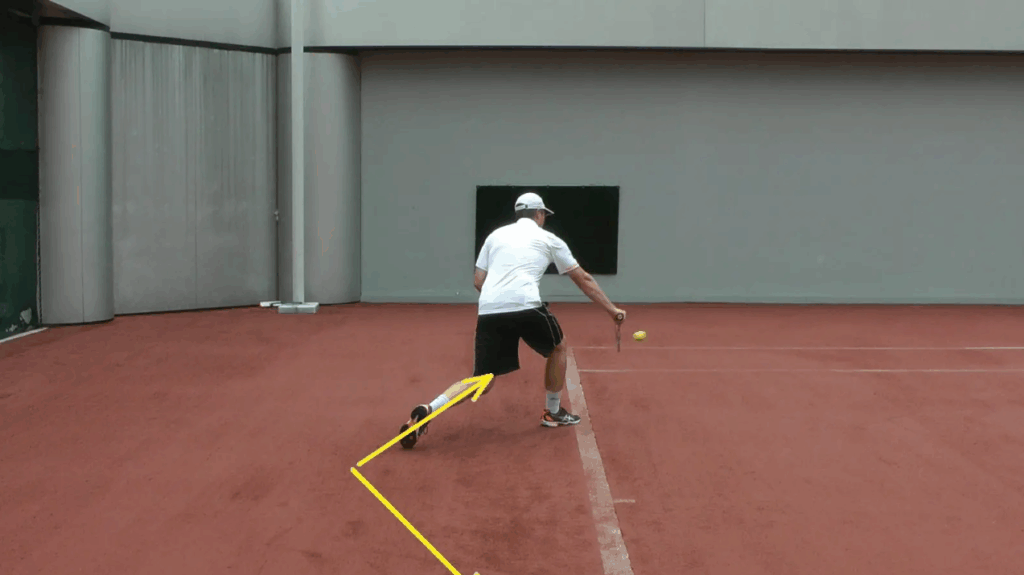To rapidly improve your tennis forehand, practice the contact point drill by hitting balls in the service box, focusing on striking slightly in front of your body. Master your footwork with proper split steps and stance positioning. Generate power through deliberate weight transfer from back to front foot rather than arm strength alone. Develop consistent topspin with a low-to-high swing path and firm wrist.
Fix common flaws by analyzing your technique and using freeze-frame drills. These fundamental adjustments will transform your forehand game.
The Contact Point Perfection Drill
While many players focus exclusively on swing mechanics, achieving the ideal contact point is often what separates good forehands from great ones. This drill helps you consistently find that sweet spot for maximum control.
Stand in the service box with a partner, feeding balls at a moderate speed. Focus on contacting the ball slightly in front of your body, with your arm comfortably extended. Start with 10 repetitions, paying attention only to your contact point, not power.
As your accuracy improves, gradually increase distance and speed. The goal is to train your muscles to hit the ball in the same place every time. When you consistently hit clean shots with minimal effort, you’ll know your contact point positioning has improved.

Mastering Your Stance and Footwork
Three essential elements of footwork form the backbone of any powerful forehand. First, your split step must occur just before your opponent strikes the ball, enabling quick reactionary movement. This timing allows you to position yourself properly for each shot without scrambling.
Your stance should be closed for defensive shots, neutral for rally balls, and open when shifting to offense. Quality footwork positioning isn’t merely about reaching the ball; it’s about creating a stable platform for power transfer from ground to racquet.
Balance throughout your swing guarantees consistency and control. Practice side-to-side shuttle drills to improve lateral movement, and incorporate diagonal running patterns to simulate real match scenarios. Remember, even perfect technique falls apart without a proper footwork foundation.

Power Generation Through Proper Weight Transfer
Because most amateur players rely solely on arm strength, they miss out on the explosive power that proper weight transfer generates. To maximize your forehand’s power, start with your weight on your back foot, then purposefully shift it forward as you swing. This transfer creates kinetic energy that flows from your legs through your core and into the ball.
Stand in a ready position with your weight slightly back, then practice stepping into your forehand while exaggerating the weight shift. Focus on feeling your body weight move from back to front foot during contact. Your racket head speed will naturally increase without forcing it with your arm. Master this technique and you’ll add significant power while reducing strain on your shoulder and elbow.

Developing Consistent Topspin and Control
Topspin is what makes a flat, unpredictable forehand different from a deep, controlled shot that you can count on. To improve your topspin forehand, brush the ball with a swing path that goes from low to high, and keep your wrist steady the whole time. It makes the ball spin, which pulls it down, so you can hit harder while still keeping control.
You can hit the ball consistently by using the same swing pattern, no matter how high or fast the ball is. Put a target three feet past the baseline and try to hit balls there with enough topspin to keep them in play. As your topspin technique gets better, you’ll feel more comfortable swinging more freely without losing accuracy.
Troubleshooting Common Forehand Flaws
Even with solid topspin technique, many players struggle with persistent flaws that limit their forehand’s potential. If you’re hitting too many unforced errors, analyze your swing path and contact point. Are you meeting the ball too early or too late? Dedicated forehand drills focusing on timing can quickly correct this issue.
Watch for a dropping elbow, which reduces power and consistency. Practice shadow swings with emphasis on maintaining proper arm position throughout your stroke. Another common problem is poor racket control during follow-through, causing shots to sail long or wide. Try the “freeze frame” drill. Complete your swing and hold the finish position for three seconds to develop muscle memory for proper technique.
Remember that most forehand flaws stem from fundamental positioning errors that simple, focused practice can resolve.
Frequently Asked Questions
How Often Should I Practice Forehand Drills for Optimal Improvement?
Practice forehand drills 3-4 times weekly for 30 minutes each session. You’ll see ideal improvement when you balance frequent training with adequate rest days to allow muscle memory development and prevent fatigue.
Can I Improve My Forehand Without a Practice Partner?
Yes, you can improve alone. Shadow swings, wall practice, target drills, and solo footwork exercises build muscle memory effectively. Use a ball machine or rebound net if available for realistic ball-striking practice.
Should I Use the Same Grip for All Forehand Variations?
No, you shouldn’t use identical grips for all forehand variations. While maintaining a consistent base grip, make slight adjustments for topspin, slice, or flat shots to maximize control and effectiveness in different situations.
How Do I Prevent Forehand-Related Tennis Elbow or Wrist Injuries?
Prevent tennis elbow by using proper technique, keeping your wrist firm, and avoiding extreme grips. Don’t snap your wrist, warm up thoroughly, use appropriate string tension, and incorporate strengthening exercises for forearm muscles.
When Should I Transition From Continental to Semi-Western Grip?
You should shift to a semi-western grip when you’re comfortable with basic strokes and want more topspin. Make this change during practice sessions, not mid-match, and allow several weeks to adapt fully.





